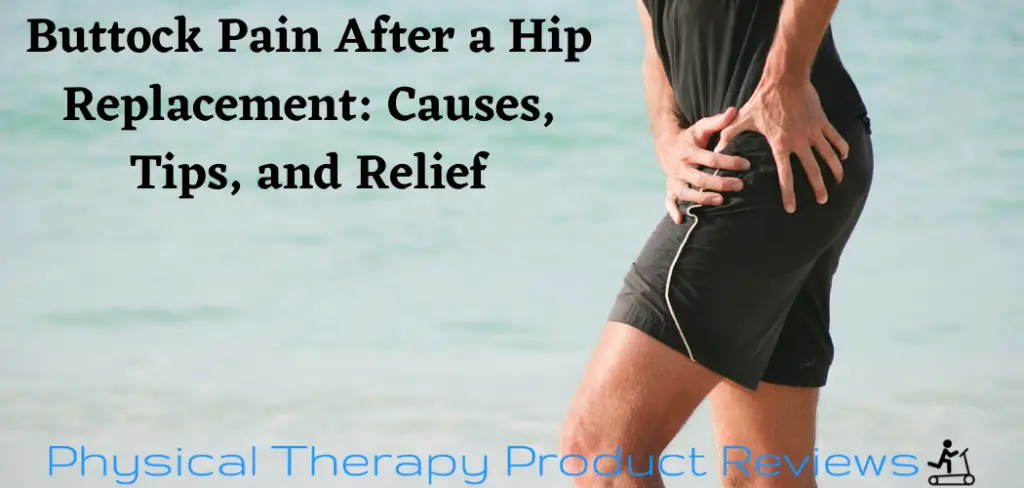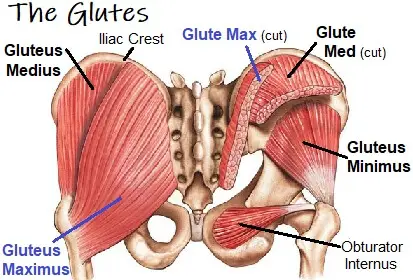You’ve had a hip replacement and you’re on the mend…but now you have buttocks discomfort too. Though it’s a pain in the bum, buttocks irritation after a hip replacement isn’t uncommon.
Kick buttocks pain in the “Tookus” by employing these exercises to ease your symptoms while you rehab from surgery.
Causes of Buttock Pain After a Hip Replacement
The hip is a big joint – the largest in your body! It’s very common for pain sourcing from any structure in this region to present to places like the front of your hip, thigh, side, or even buttocks.
Buttock pain is actually the most common site for referred pain from the hip! And where you’re feeling pain can be a clue for what is causing it.
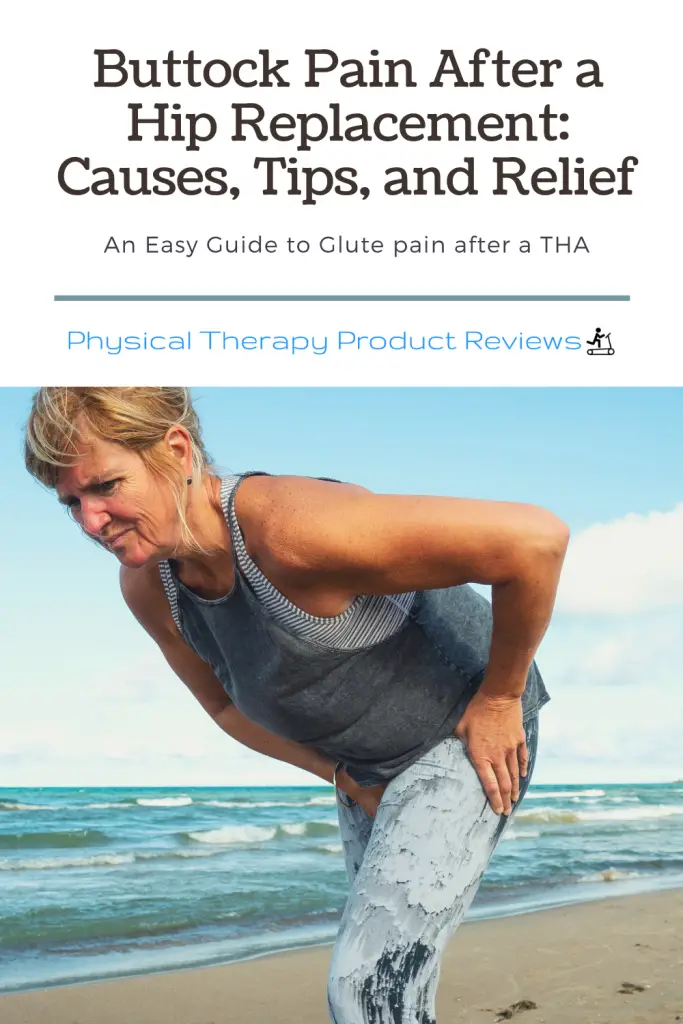
What could pain in the buttocks be? Most commonly, pain in the buttocks after hip replacement is due to:
- Acetabular (joint) irritation
- Gluteal tendinopathy
- Iliopsoas tendonitis
- Gluteal weakness
Rarely, gluteal pain after hip replacement surgery could be due to nerve entrapment, muscular damage, or prosthetic issues.
Buttocks pain that does not respond to consistent conservative treatment can be discussed with your medical provider.
A View From the Back
Your buttocks region is made of large and powerful muscles (you know, those ones you sit on top of!) shielding your bony pelvis and cradling your hip socket. Within this area are muscles, bones, bursa, tendons, nerves, and more. It’s a busy place.
When pain occurs near the hip joint, it doesn’t have to travel far to feel like it’s coming right from your buttocks!
This means that some of the pain in the backside of the hip could also be coming from other structures such as the low back, SI joint, and any of the other surrounding muscles are recovering.
How Long Does Glute Pain Last After a Hip Replacement
Symptoms after hip replacement, including glute pain, may last several weeks. Neither is it uncommon to continue to have discomfort for two months, though it should be mild.
Pain in the buttocks can lead to trouble sitting, standing, walking, and exercising. When pain starts interfering with daily life, that’s a sign you need to address it.
Most glute pain after surgery should go away by at least the 3 months after the surgery mark. On some occasions, it can last longer so don’t be alarmed if this is you.
Tips to Decrease Buttock Pain After a Hip Replacement
In the first 6 weeks after surgery, use light stretches to alleviate your pain. You can also perform Soft Tissue Mobilization (described below). The strengthening exercises in this guide will improve muscles that support the hip, and take the stress off of irritated glutes.
Pro Tip: You may have additional precautions depending on your specific surgical procedure, like if you had a hip arthroscopy with a lateral approach.
Consult with your surgeon or physical therapist for any specific exercises or motions to avoid.
Exercises for Glute Pain After a Hip Replacement
Glute Soft tissue mobilization
Use a foam roller, or massage ball, to apply pressure to your buttocks. It may feel sensitive, but find the amount of pressure you can tolerate without a significant increase in symptoms.
There are a few different positions you could use for this activity, based on your time out of surgery and level of comfort/ability:
- Place the roller/ball on a wall and lean against it, attempting to place pressure over your painful area.
- Place the roller/ball in a sturdy chair and sit on top of it.
- Place the roller/ball on the floor and lay or sit on top of it.

Rotate your body slightly side to side or up and down to provide a rolling motion across the region.
Continue rolling for about 30 seconds, then rest. Repeat for 3 sets.
Mini Squats
Lean against a wall (you can place a Swiss ball between you and the wall for easier squatting) and step your feet out a few steps. Keep your torso upright and begin to bend your hips and knees to come into a small squat.
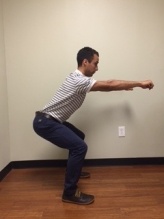
Make sure your knees do not extend too far beyond your toes. Hold for a few seconds, then return to stand.
Repeat 12x, hold for 3-5 seconds in each squat. Complete 3 sets.
Hamstring Stretch
Sit on the edge of a chair. Extend your leg out in front of you and keep your knee straight. Sitting upright, begin to bend forward from the hip, maintaining a straight lower back, until you feel a stretch behind your leg.
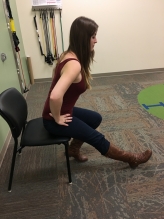
Hold here, then slowly return upright. You don’t need to reach forward for your toes!
Repeat 3x, hold for 30 seconds.
Side Lying Clamshells
Start by lying on the opposite side from the one you had surgery with your knees and hips bent. Take your top leg and rotate it up to the ceiling without rotating the rest of the body. Slowly return it back to the other leg and repeat.
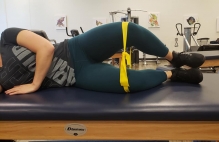
To make this exercise most challenging you can add a resistance band around the knees to really make that buttock burn!
The clamshell exercise is one of our favorite exercises because it is so easy to do at home and targets muscles in our hips that often get neglected.
Keep Going! Move as Much as You Can After Surgery
Exercises like hip and core stabilization will be very beneficial for supporting your joint and glute muscles. Aquatics activities can also provide a weight-free environment for practicing your range of motion and resistance exercise.
Speak with your physical therapist if your buttocks pain persists past 6 weeks post-op. There may be other modalities or hands-on therapy to attempt to further alleviate your symptoms.
Conclusion
Many patients experience buttocks pain after a hip replacement. It may be common but it’s far from pleasant. You can use these guidelines to help reduce your symptoms and start looking forward instead of back!
References:
Elzaine A, Borger J. Anatomy, bony pelvis and lower limb, gluteus Maximus muscle. StatPearls. 2021. https://www.ncbi.nlm.nih.gov/books/NBK538193/
Ferrata P, Carta S, Fortina M, Scipio D, Riva A, Di Giacinto S. Painful hip arthroplasty: definition. Clinical Cases in Mineral and Bone Metabolism. 2011; 8(2): 19-22.
Hip arthroscopy. Physical Therapy Section William Beaumont Army Medical Center. 2008. https://william-beaumont.tricare.mil/Portals/149/Hip%20Arthroscopy%20WB08.pdf
Lesher JM, Dreyfuss P, Hager M, Kaplan M, Furman M. Hip joint pain referral patterns: a descriptive study. Pain Medicine. 2008; 9(1): 22-25.
Uchida S, Kizaki K, Hirano F, Martin HD, Sakai A. Postoperative deep gluteal syndrome after hip arthroscopic surgery. Orthopaedic Journal of Sports Medicine. 2020. https://journals.sagepub.com/doi/full/10.1177/2325967120951118
Disclaimer: The information provided in this post is for educational purposes only. This is not a substitute for a medical appointment. Please refer to your physician before starting any exercise program.
